
The displacement of the traditional culture of Nauru by contemporary western influences is evident on the island. Little remains from the old customs. The traditions of arts and crafts are nearly lost.

The displacement of the traditional culture of Nauru by contemporary western influences is evident on the island. Little remains from the old customs. The traditions of arts and crafts are nearly lost.

The inhabitants of Nauru wear the usual tropical clothes: short trousers and light shirts. Fishing still follows a traditional method: the island anglers wait in small light boats for fish to arrive. The custom of fishing by trained frigatebirds has been preserved.
Nauruan folk songs existed as of 1970, [1] while Oh Bwio Eben Bwio is a noticeable folk song. [2]
Whilst the traditional culture rapidly gives way to the contemporary, as elsewhere in Micronesia, music and dance still rank among the most popular art forms. Rhythmic singing and traditional reigen [n 1] are performed particularly at celebrations. At least, a historical form of a Nauruan dance called fish dance in English was record in a form of photographs. [4] [5] Known contemporary dances are the frigate bird dance and the dogoropa. [6] [7]
Craftsmen make articles of clothing and fans of Kokosfasern and the sheets of the screw tree and use geometrical samples, which resemble those of the Indonesian culture. Also the wood of the kokospalme is used for the production of arts and crafts.[ citation needed ]
The language of Nauru, Dorerin Naoero, is a Micronesian language. English is understood and spoken widely.
Education is compulsory from 4 to 16, in all the schools on the island. The University of the South Pacific has a centre in Nauru located in the Aiwo District and offers pre-school teacher education, nutrition and disability studies and will offer the Community Workers Certificate. The campus offers Audio and video conferencing facilities, library and computer laboratory as well as internet and email access via USPNet are available for students. For secondary and university education, most Nauruans' children must go abroad. During its prosperous years these children were sent to Australia but now were sent to Fiji.
The official national holiday is the independence day on 31 January, but Angam Day, 26 October, is considered as an additional national holiday.
The Nauruan words of the national anthem were written by Margaret Hendrie and adopted in 1968 upon the Republic of Nauru's independence.

The most popular in Nauru is Australian rules football. A 12-team senior league operates in the country, see Australian rules football in Nauru and it is a popular spectator sport. Nauru has competed internationally in Australian rules football at the Arafura Games, Australian Football International Cup and Barassi International Youth Tournament. The national team, the "Chiefs", ranked 8th in the International Cup in 2002 and gold medal at the Arafura Games.

Nauru's national basketball team made the headlines internationally at the 1969 Pacific Games when it beat the Solomon Islands, which have almost 60 times of Nauru's population, and Fiji, which has almost 100 times of Nauru's population.
Nauruans also play soccer, softball, tennis, sailing, and swimming. Golf is accessible in Menen Hotel. [8] There are only a few sport grounds in Nauru. The only stadium is in Yaren, but it is obsolete and fails to meet international standards. A larger and more modern sports stadium is being built in Meneng, however lack of money has caused the project to stall. The current stadia are:
A traditional 'sport' is catching birds (Black Noddy) when they return from foraging at sea to the island towards sunset. The men then stand on the beach ready to throw their lasso. The Nauruan lasso is supple rope with a weight at the end. When a bird comes over they throw their lasso up, it hits and or drapes itself over the bird, which then falls down and is seized and are roosted as pets.
Eakabarere is a traditional form of Nauruan wrestling. Weightlifting is also one of the more traditional sports in Nauru.
The island features in the 1941 radio play Drift .
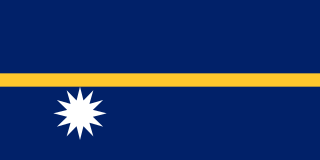
Nauru, officially the Republic of Nauru and formerly known as Pleasant Island, is an island country and microstate in Micronesia, part of Oceania in the Central Pacific. Its nearest neighbour is Banaba of Kiribati, about 300 km (190 mi) to the east.

Yaren is a district of the Pacific island country of Nauru. It is the de facto capital of Nauru and is coextensive with Yaren Constituency.
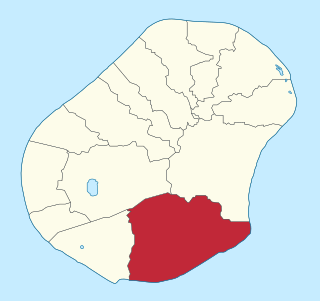
Meneng is a district located in the Meneng Constituency in the country of Nauru. The constituency elects 2 members to the Parliament of Nauru in Yaren.

Aiwo is a district in the Pacific country of Nauru. Jarrit Morpak is the city's mayor, elected in 2008. It belongs to Aiwo Constituency.

Nibok is a district in the island nation of Nauru in the Micronesian South Pacific. It is located in the west of the island and covers an area of 1.6 square kilometres. Nibok is a part of the Ubenide Constituency. As of 2021, the population was 724.

Boe is a district in the country of Nauru. It is the only district of Boe Constituency.

Denigomodu is a district in the western part of the island of Nauru. It is the most populous district in Nauru.
Meneñ Stadium is a former stadium on the island Nauru. It is located in the Meneng District. Constructed in 2006, it had a capacity of 3,500 spectators. Unlike other stadiums on the island, Meneñ Stadium had bleachers for spectators.

Angam Day is a holiday recognised in the Republic of Nauru. It is celebrated yearly on 26 October.
The Micronesians or Micronesian peoples are various closely related ethnic groups native to Micronesia, a region of Oceania in the Pacific Ocean. They are a part of the Austronesian ethnolinguistic group, which has an Urheimat in Taiwan.
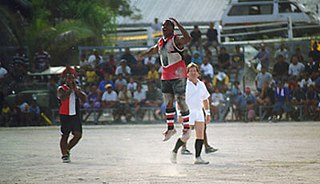
Australian rules football in Nauru dates back to the 1910s. Australian rules football became the national sport of Nauru after its independence in 1968. Today, its national participation rate is over 30%, the highest in the world.

The Nauru national Australian rules football team, nicknamed the Chiefs, represents Nauru in Australian rules football. Despite its small size and population, Nauru, which is the only country with Australian football as its national sport, consistently ranks among the top eight teams in the world.
Yukio Stinson Peter is a weightlifter from Nauru.

The following outline is provided as an overview of and topical guide to Nauru:
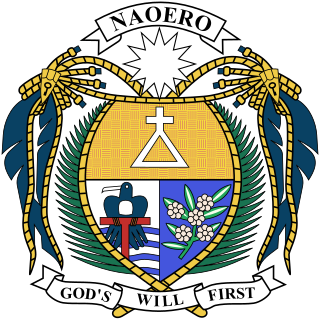
Nauruan nationality law is regulated by the 1968 Constitution of Nauru, as amended; the Naoero Citizenship Act of 2017, and its revisions; custom; and international agreements entered into by the Nauruan government. These laws determine who is, or is eligible to be, a national of Nauru. The legal means to acquire nationality, formal membership in a nation, differ from the domestic relationship of rights and obligations between a national and the nation, known as citizenship. Nauruan nationality is typically obtained either on the principle of jus soli, i.e. by birth in the Nauru or under the rules of jus sanguinis, i.e. by birth to parents with Nauruan nationality. It can be granted to persons with an affiliation to the country who has lived in the country for a given period of time through naturalization.
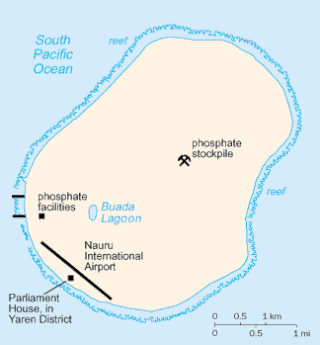
Nauru is a small, isolated western Pacific island, which lacks many of the tourist facilities of some of its larger neighbours, such as Fiji, the Cook Islands, or even New Caledonia. Tourism is not a major contributor to the economy, with more than 200 tourists a year visiting the island.
Topics related to Nauru include:

Education in Nauru is compulsory for children between the ages of 5 and 16. There are eleven schools in Nauru, including three primary schools and two secondary schools. There is an Able/Disable Centre for children with special needs. Education at these schools is free. In 2011, the Australian Department of Foreign Affairs and Trade reported that 3,026 children were enrolled at Nauru's schools. The previous Minister for Education was the Hon. Charmaine Scotty, MP from 2013. The current Minister is Asterio Appi.
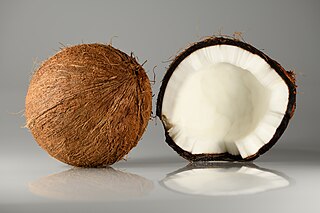
The cuisine of Nauru is the traditional cuisine of the island state on the Pacific Ocean.
Samuel Edwin Tsitsi was a Nauruan politician.
The Nauruan dances which I have seen are not notable for their wealth of distinct figures. They are accompanied by singing and consist in tripping to and fro, swaying the body, slapping the thighs and chest and making turns.
At the Pacific Festival of Arts in 1985 and 1988, sixth-graders at the Nauru Primary School presented the frigate bird (iti), a Nauruan dance. The students practiced daily for two months. The boys clapped and sang while the girls danced, por-traying te birds' flight and perching.... In 1994, at the Children's Convention in Fukuoka, Japan, ten eleven-year-old boys and girls from Nauru performed the dogoropa, a dance with sticks, which men and women from Nauru had performed at the Festival of Arts in 1980.